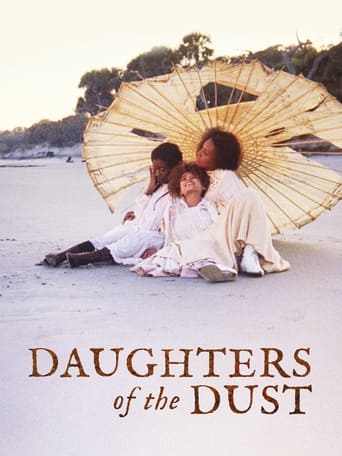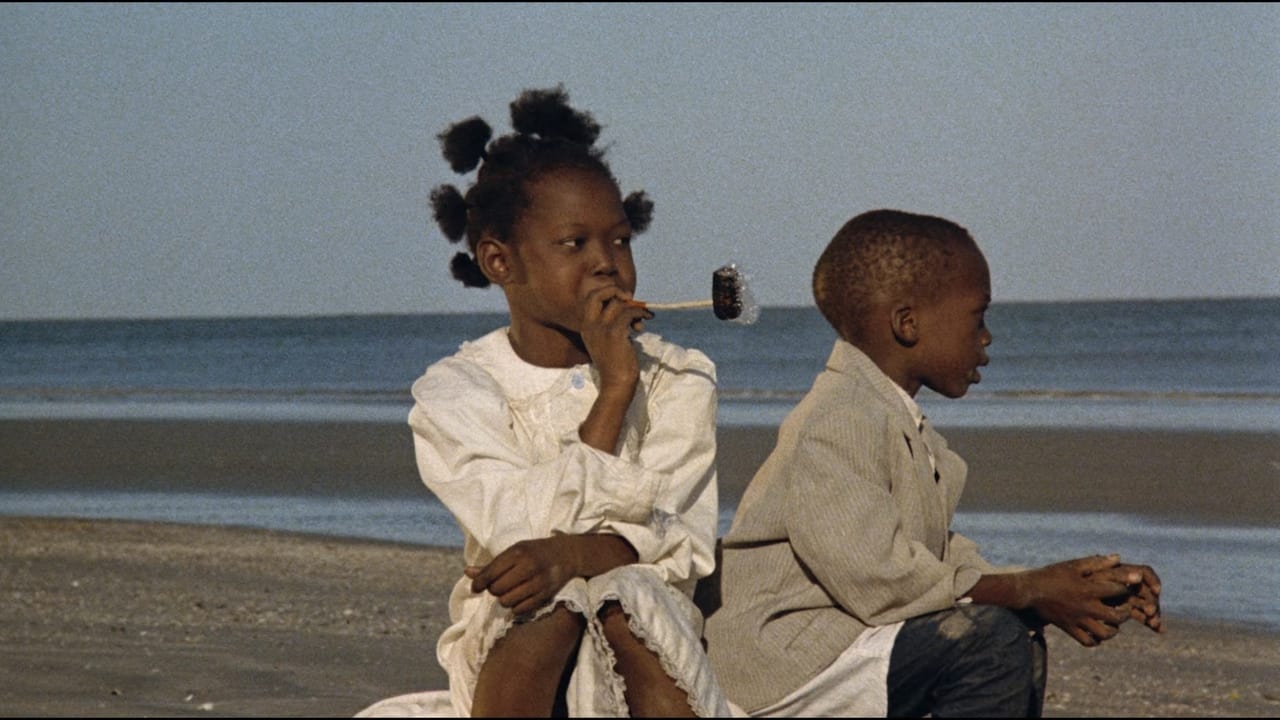Polaris_DiB
This would be the second non-abstract movie I've seen without a plot. The other one was Morvern Callar, and I must say this one beats that one out by a long shot because this one actually had symbolism and intended meaning. The loose plot-like structure is about a bunch of African-Americans in 1902 who had lived in isolation on an island for years and were getting ready to go back to Africa, only now they had to deal with issues of the African diaspora and displacement and what it means to their identity.Very rich visuals are about one of the only things that can really keep your attention going in this film, but if you sit down and force yourself to pay attention you can get a lot out of the dialog as well. It just requires an extra amount of effort to pay off, but once you expend that effort you might just get something out of it.A little more difficult is the fact that at least four different distinct languages are spoken in this film, with only one moment done with subtitles. The languages I caught besides English were German, French, and Arabic (?) but there may very well have been much more (I think there was a little Spanish and some Latin as well).I can't really speak much about the technical qualities of the film other than the fact that the symbolism and imagery are amazing and the script is tedious. It's really hard to focus on more than that, unfortunately.--PolarisDiB
erock02
Daughters of the Dust directed by Julie Dash is a cultural perspective look into the lives of an African American family left on an island years after being torn from their heritage of Africa for slavery only to have revolted and be left to themselves, stranded on the island off the coast of the Southern eastern coast and the family who live off the island with others who long to find their heritage. The film's story line is developed in the one day where the family is getting ready to head to a new world on the main land. The internal conflict of the family between relatives who no longer live on the island who have become part of the culture of America post civil war and the family left on the island that live by the old heritage and customs. The family on the island struggle between their history and culture to the change of the times and the need for conformity. This film centers on the generations of the family from the young children who are filled with life then to the adults who are torn between their decisions to leave to finally the center character, the elder grandmother of the family Nana. Nana's ways and beliefs that have been accepted by the family their entire lives are now the only thing holding the family back from their future off the island. The film focuses largely on the women of the family, displaying the differences of ones who that have lived on the island and then those whom have lived off it. The lines divided between the two are evidently shown throughout the film. The women who lived off the island no longer take to heart their heritage that Nana lives by. They find it to be uncivilized and against the teaching of the bible. There is the scene in which the family after much struggle and torment accept Nana's decision to stay and her heritage. The scene is of the entire family gathered around the grandmother in which she has a lock of her hair and others placed on a bible asking everyone to believe in the old ways and take her with her by kissing the hair and bible. Finally, the scene acts as importance because one of the outside family members whom diligently preaches and believes in Christianity gives in to Nana's request.Daughters of the Dust cannot be explained without stating the mise en cinema. From the clothing to the shots of the landscape of the island all resemble the time and place of the film. Not only the background and clothes, but also the character themselves turn this limited distributed film into a believable representation of what people of this time would act and be. The storyline background of the slavery uprising actually having taken place on the island gives it enormous creditability. The shots of the island start the creditability of the film with shots of the women interacting with the water of the ocean and the rivers, the shots of the forest and trees, and finally the most significant may be when the women are preparing the dinner showing how their food is prepared with live seafood and spices gathered from the island. The mise en cinema is creditable because of the clothes as well; from Nana who has only a dress is indigo, which was the main produce to harvest by the slaves on the island to the white Victorian dress of the women from the main land.Dash's Daughters of the Dust cannot be denied as a cultural perspective that's originality has touched on the transition to the new culture of African Americans and they past that many have forgotten after the postwar civil war era. Its cultural insight may have been directed to a certain selected target audience, but its look into the heritage of the people cannot be viewed as anything but a respectable insight of the times.
JohnDoe21
SPOILER BE AWARE OF A SPOILERThe film `Daughters of the Dust' is a film that gives us the audience a feeling of what happened to African Americans after slavery and before the modernization of the times. This film was set in 1902 and is set on an island with a group of African Americans who are all in some form or another part of the same family. The fascinating thing about this film is that there are multiple generations of people that live on this island. In this film the dilemma is that the family is getting ready to leave the island to go to the main continental United States. The problem is that many family members feel differently about this journey to the new world. However, they were not the first ones to decide to leave. One of their relatives Yellow Mary, and another went and left this island and returned to help the others to leave. This story takes so many different turns, and has so many stories in it. There is Yellow Mary's transformation from wanting to be on the move all the time; to deciding that she wishes to stay on the island she left in the long ago at the end of the film. There is the young girl who is in love with the Native American who helps them with the work. In the end she to stays on the island and leaves her over powering mother to go to the new world with her other children. This part of the film was not very detailed, however I believe this is the best part. Whenever the Native American was shown, it appeared that he was at one with nature, and understood more things than any of us will ever know. In one scene he wrote a letter to the girl that he loved and that loved him. While she was reading the letter it was showing him sitting in a tree, and the view kept getting wider and further away. It made this man look very peaceful and caring. It also gave him the image most people have when they think of Native Americans in nature, at one with it. Another major part of this film revolved around the eldest of the group. They all called her Nana and she was so old that she had been around when there was slavery just like a few other members of the group. It was interesting how they showed the eldest people who were part of slavery had iodine permanently on their hands, to show that they worked on the plantations and dealt with what we all think of as slavery. Anyway, she was resistant to the whole family leaving this island of theirs. She wanted them all to stay and be a family, and to pass on the ways of the past to the future. Unfortunately, in the end the all left except for her, the young girl, Yellow Mary, and another couple. Finally, there is the story that revolves around the couple who are about to have a baby. The woman got pregnant by being raped, and the man did not know quite how to handle it. In the beginning the man was so happy to be going to the main land, and in the end they decided to stay there with the others. Throughout the film there was a narrator and the narrator was the unborn child, and she was discussing the story of what happened and led up to her mother and father staying on the island. The end was very powerful because it the make it very clear that it was very important for Nana to have the children born on this island, and she at least got to see the baby before she died. It was very powerful to have this narration throughout the film. Overall, I really did not enjoy this film but that is ok. It is just not the type of film I am use to watching. The drama films especially about family problems are my least favorite types of films, but I can see how some people would like it a lot.
jason-harre
Turning the Page for African-American FilmsThe mid nineteen eighties and early nineties were chock-full of films displaying discriminating evidence against the African-American community. Films such as Boyz in the Hood, Menace to Society, and Friday demonstrated a stereotypical theme of gangbanging hoodlums that settled into the minds of the nation. If films representing the African-American man weren't incriminating enough, the alternative option was misrepresentation through the music industry. Milli Vanilli, once proven unauthentic, made an embarrassing impression that is still humored on late night television. MC Hammer, LL Cool J and other music artists help to upturn the music industry with their ability to direct trends for urban culture. Artists fresh new styles were a simple antidote for one industry. However, the film industry was still rendered and in search of its hero. The hero finally came in Julie Dash's Daughter's of the Dust in 1991. A deeper search than black baggy pants had to come along for an impact to be felt. The deeper search led Julie Dash into African-American history and a peasant family from a subculture known as Gullah. Dash's poetic portrayal relieved the nation's minds of problems in the black community by celebrating its past. While the film was still very dramatic, it was able to capture the audience with its breathtaking scenes. Most famous of which was the picnic scene that the family found itself in a debate of traditional and modern ways.This film had its twist and turns but made a lasting impression with its individuality from other films. The characters all had climatic problems, but were portrayed as free and independent from the hardships that are faced by poor urban society today. This made for a break in the downward trend of a current representation of the black community. Jokingly, this film should be more highly regarded than even MC Hammer's legendary baggy pants.


 AD
AD





